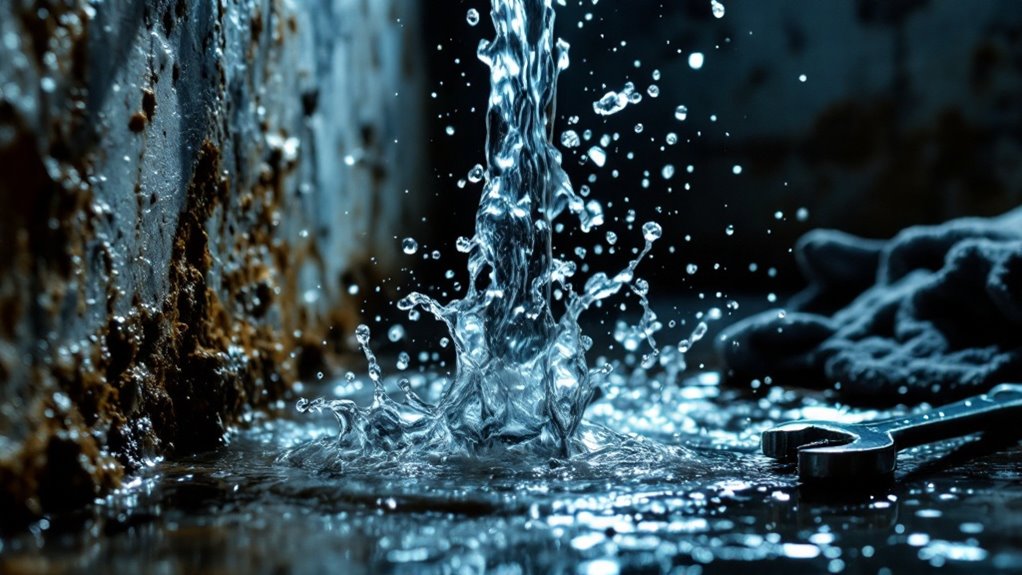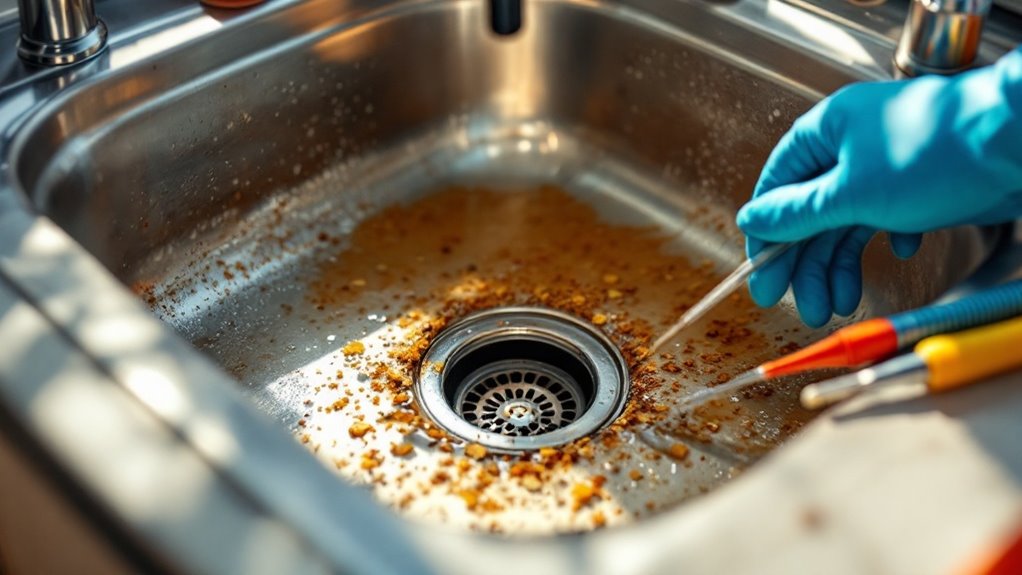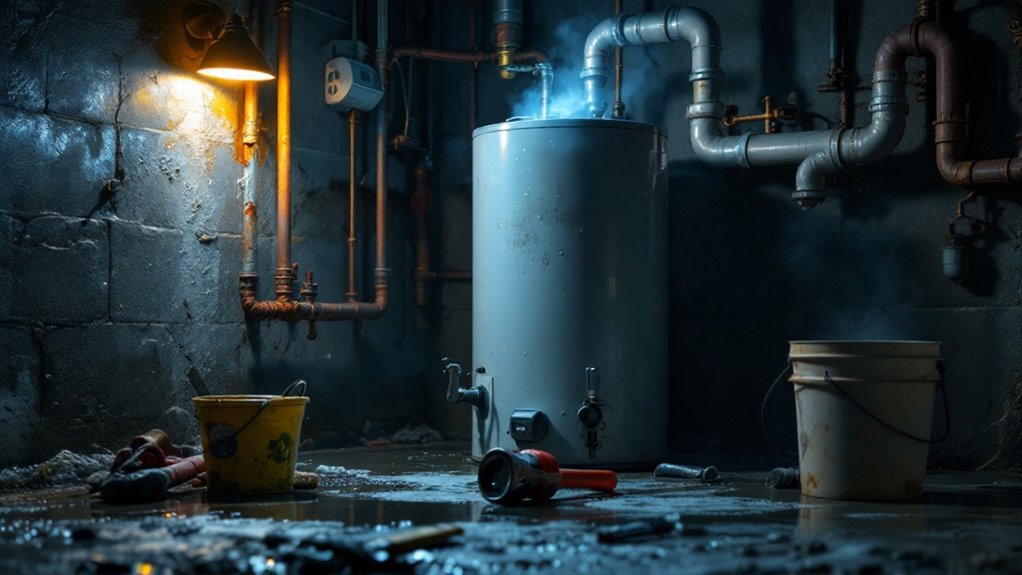In Stockbridge, you'll want to be aware of common plumbing emergencies like burst pipes, overflowing toilets, clogged drains, leaking fixtures, and water heater failures. Each of these issues can cause significant damage if not addressed quickly. For instance, frozen pipes may burst, and toilets can overflow unexpectedly. Regular maintenance can help prevent these emergencies, but knowing how to respond is essential. Keep an eye out for more insights on managing these plumbing challenges effectively.
Key Takeaways
- Burst pipes are a common emergency caused by freezing, corrosion, or high pressure; proper insulation can prevent them.
- Overflowing toilets can lead to water damage; shut off the valve and use emergency supplies for cleanup.
- Clogged drains often manifest as slow drainage or gurgling; use a plunger or plumber's snake for effective resolution.
- Leaking fixtures can indicate hidden issues; regular inspections and monitoring water bills can help detect leaks early.
- Water heater failures may present as noise or leaks; check power supply and thermostat settings for troubleshooting.
Burst Pipes: Causes and Immediate Steps to Take

Burst pipes can lead to significant water damage and costly repairs, making it crucial to understand their causes and how to respond quickly. Common causes include freezing temperatures, corrosion, and high water pressure. To prevent this, you should guarantee proper pipe insulation, especially in unheated areas. If you suspect a pipe has burst, act fast. First, locate your emergency shutoff valve and turn it off to stop the water flow. Then, drain faucets to relieve pressure and minimize leaks. Assess the damage and call a plumber for professional help. Remember, swift action can save you from extensive repairs and protect your home from further harm. Your proactive response makes all the difference in these emergencies. Additionally, contacting a 24/7 emergency plumbing service can ensure you receive prompt assistance when needed.
Overflowing Toilets: How to Manage the Situation
When a toilet overflows, it can quickly create a stressful situation, especially if you're unprepared. To manage the overflow, follow these steps:
- Shut Off the Water: Locate the shut-off valve behind the toilet and turn it clockwise to stop the flow.
- Clear the Area: Remove any items around the toilet to prevent water damage and make cleanup easier.
- Use Emergency Supplies: Grab towels, a mop, and a bucket to soak up water effectively.
Regular toilet maintenance can help prevent future issues. Always keep emergency supplies handy, like a plunger and a wrench, to tackle minor problems before they escalate. By staying prepared, you can handle toilet emergencies with confidence and minimize damage to your home. Additionally, knowing how to contact an emergency plumbing service can provide peace of mind during these stressful situations.
Clogged Drains: Signs and Quick Fixes

Clogged drains can disrupt your daily routine, leading to frustrating backups and potential water damage if not addressed promptly. Recognizing the signs is essential; watch for slow drainage, gurgling sounds, or unpleasant odors. Regular drain maintenance can help prevent these issues.
If you notice a clog, grab some basic plumbing tools like a plunger or a plumber's snake. Start with the plunger for minor clogs, applying firm pressure to dislodge the blockage. If that doesn't work, the plumber's snake can reach deeper clogs, breaking up debris effectively. For persistent issues, consider a mixture of baking soda and vinegar as a natural alternative. Keeping your drains clear not only saves you time but likewise protects your home from costly repairs.
Leaking Fixtures: Identifying and Addressing Leaks
While addressing clogged drains is important for maintaining your plumbing, leaking fixtures require immediate attention to prevent water waste and potential damage. Identifying leaks early can save you money and stress. Here's how you can tackle leak detection and find effective repair solutions:
- Inspect regularly: Check under sinks, around toilets, and behind appliances for water stains or puddles.
- Listen for sounds: Pay attention to dripping noises, indicating a possible leak.
- Monitor your water bill: A sudden increase may suggest hidden leaks.
Once you identify a leak, consider simple repair solutions like tightening fittings or replacing washers. If the problem persists, don't hesitate to consult a professional to guarantee your plumbing remains in top shape.
Water Heater Failures: Troubleshooting Common Issues

If your water heater isn't performing as expected, you might notice signs like inconsistent temperatures or strange noises. Understanding common causes of failure can help you pinpoint the issue quickly. We'll cover some DIY troubleshooting tips to get your heater back in working order.
Signs of Malfunctioning Heater
When your water heater starts showing signs of malfunction, it's crucial to address the issues promptly to avoid further complications. Here are three key signs to look out for:
- Heater Noises: If you hear unusual sounds like popping, rumbling, or hissing, it's a signal that something's off.
- Temperature Fluctuations: If your water isn't consistently hot, you might experience uncomfortable showers and inefficient heating.
- Leaks: Puddles or moisture around the base of your heater can indicate serious problems that require immediate attention.
Common Causes of Failure
Understanding the common causes of water heater failures can help you troubleshoot issues before they escalate. One major culprit is pipe corrosion, which can lead to leaks and reduced efficiency. Over time, minerals in your water can erode pipes, causing them to break down and create problems. Another issue is inconsistent water pressure. If the pressure is too low, your water heater may struggle to operate effectively, while high pressure can stress the system, leading to potential damage. Moreover, sediment buildup in the tank can hinder performance, resulting in inadequate heating. By recognizing these causes, you can stay ahead of potential failures and maintain a reliable hot water supply in your home.
DIY Troubleshooting Tips
While water heater issues can be frustrating, a few simple DIY troubleshooting tips can help you identify and resolve common problems before calling a professional. Start by gathering your plumbing tools and emergency supplies; you'll need a multimeter, screwdrivers, and a wrench. Here are three steps to tackle water heater failures:
- Check the Power Supply: Confirm the heater's circuit breaker is on and there's power to the unit.
- Inspect the Thermostat: Verify the thermostat settings; it should be set between 120°F and 140°F.
- Examine the Drain Valve: Look for leaks around the drain valve; tighten it if needed or replace it if it's faulty.
These steps can save you time and money while keeping your water heater running smoothly.
Sewer Backups: Recognizing the Warning Signs
Sewer backups can cause significant damage to your home and health, so recognizing their warning signs early is crucial. One of the first indicators you might notice is the presence of sewer odors. If you detect a foul smell, it could mean waste is accumulating in your pipes. Furthermore, keep an eye out for drainage issues; slow-draining sinks or toilets can signal a problem. If multiple fixtures are backing up at once, that's a red flag. You may likewise hear gurgling noises when flushing toilets or running water, which often points to a blockage. Addressing these signs promptly can help prevent severe damage and costly repairs, ensuring your home remains safe and healthy for you and your family.
Frequently Asked Questions
How Can I Prevent Plumbing Emergencies in My Home?
To prevent plumbing emergencies, you should prioritize routine maintenance and water conservation. Regularly inspect pipes for leaks, clean drains, and be mindful of water usage. These steps can save you from costly repairs and unexpected issues.
When Should I Call a Professional Plumber?
When plumbing issues feel like a ticking time bomb, don't hesitate. If you notice emergency signs like leaks, strange noises, or low water pressure, it's time to call a professional to address the plumbing urgency.
What Tools Are Essential for Basic Plumbing Repairs?
For basic plumbing repairs, you'll need crucial tools like pipe wrenches for gripping and turning pipes, and drain snakes for clearing clogs. Having these handy can make your repairs smoother and more efficient.
How Often Should I Inspect My Plumbing System?
You should perform routine checks on your plumbing system at least twice a year. Look for plumbing signs like leaks, corrosion, or unusual noises to catch potential issues early and prevent costly repairs down the line.
Are There Plumbing Issues I Can Fix Myself?
You can tackle some plumbing issues yourself, like fixing common leaks. DIY repairs, such as tightening faucet connections or replacing washers, can save you money and time, giving you confidence in your home maintenance skills.
